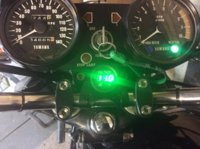Alex Wagers
XS650 Enthusiast
I have a 1980 XS Pamco/ PMA swap and was curious what everybody is running as far as bulb type and proper headlight/ taillight bulb wattage on their bikes? Also Is it true by running a slightly higher wattage bulb it will “ use up” some of the extra juice my pma is possibly putting out? I have no exta acceriories on my bike simply headlight hi/ low, turn signals, horn, volt gauge which should be in this week and of course the bike is kick only. Any further information is greatly appreciated. Thanks!

